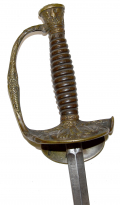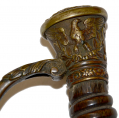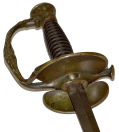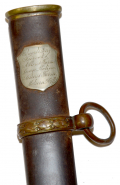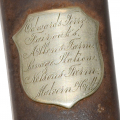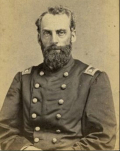site search
online catalog
REVEREND GENERAL AND FIGHTING CHAPLAIN: 1860 STAFF SWORD PRESENTED IN 1861 BY HIS STUDENTS TO REVEREND J.B. VAN PETTEN: CHAPLAIN TO FIELD OFFICER AND BREVET BRIGADIER GENERAL, WOUNDED IN ACTION AT THIRD WINCHESTER AND CITED FOR GALLANT CONDUCT

$4,395.00 SOLD
Originally $5,850.00
Quantity Available: None
Item Code: 870-397
Changing from a non-combatant chaplain charged with saving souls to a field-grade combat officer responsible for taking lives, and then returning to civilian life in academia obviously requires some soul-searching and adjustments, but the remarkable officer who owned this sword managed to do it.
This is an early example of a scarce pattern of sword. Adopted for officers, “of the general staff and staff corps” in 1860, it was also carried by general officers, but many who were entitled, or even required, to carry it preferred the 1850 patterns. It is also frequently confused with 1872 and later field and line officers’ swords. See Thillmann, Civil War Army Swords, for a discussion of the pattern and elements that distinguish these wartime swords.
This follows the regulations with a horn grip in good condition with ferrules top and bottom, though lacking the wire that would run in the spiral groove. The lantern pommel correctly has an eagle on one side and blank shield on the other. The knuckleguard features coiled lightning bolts emanating from a central rosette, and has a branch near the guard meeting the obverse fixed counterguard bearing a deeply cast eagle clutching arrows and olive branch, but no U.S. shield on its chest, superimposed on flags at left and right. The brass has a medium, aged patina with just some rubbing to lighter color on the raised areas. The reverse folding counterguard, lacking the spring button, which is often the case, bears a very nice inscription reading:
“REV. J.B. VAN PETTEN / Chaplain 34th Regt. / N.Y.S.V. by the Students / Fairfield Seminary / July 1861”
The blade is arris shaped (diamond in cross-section) with good edge and point. The ricasso shows a little corrosion near the guard, but a “B” proofmark on one side and clear recessed shield-shaped blade mark with a raised “S” indicating a Klingenthal product. The etching is light and mixed with some gray, but the motifs include floral scrolls and stands of arms and crossed flags. The scabbard is the regulation metal pattern, now a plum brown, generally smooth, but a little crusty near the throat and showing some thin rust at the inside edges of the plain brass drag. The brass throat is in place as well, as are the two ring mounts, which bear cast leaves on the obverse and are plain on the reverse, the upper mount correctly carrying a single ring like the middle mount. The brass has a pleasant, mellow patina. The obverse of the scabbard bears an applied silver shield plainly applied in later 1862, engraved with battle honors: “Edwards Ferry / Fair oaks / Allen’s Farm / Savage Station / Nelson’s Farm / Malvern Hill.” The first was a river crossing and engagement fought bu Gorman’s brigade of Stone’s division in conjunction with that at Ball’s Bluff, fought four miles upriver. The others were engagements in McClellan’s peninsular campaign, where it fought in the 2nd Corps.
Son of Peter and Lydia Van Petten, John Bullock Van Petten was born 6/19/1827 in Sterling, NY. He graduated from Wesleyan University with a B.A. in 1850, an M.A. in 1853 (and later a Ph.D. in history from Syracuse University.) He was a Methodist/Episcopal clergyman and when war broke out was principal at the co-educational “Fairfield Classical Academy and Female Collegiate Institute” in New York. In some sources, the school is referred to as the Fairfield Academy or the Fairfield Seminary, indicating the sword was presented by the student body as a whole, many of whose male members were themselves going into the army. A New York History article, however, identifies Van Petten as the principal specifically of the “Ladies Seminary,” of the “Fairfield Classical Academy and Female Collegiate Institute,” indicating the sword is a very uncommon example of a presentation by female students to a faculty or administration member.
In accordance with his religious background, Van Petten first went into the army as a Chaplain, enrolling in the 34th NY at Albany at age 40, to serve two years. He mustered in 6/15/61, receiving a commission dated 7/4/61 giving him rank from 5/30/61. The regiment served in Stone’s brigade and then Stone’s Division, until March 1862 when it joined Sedgwick’s Division of the 2nd Corps, a hard-fighting organization. It saw considerable action on the Peninsula, losing 29 killed and mortally wounded at Fair Oaks and 7 killed in the Seven Days, all during Van Patten’s service and explaining the battle honors on the applied silver shield. The regiment also saw heavy action and losses at Antietam, but it is not clear Van Patten was on the field. His name is on the regiment’s monument there, but in a complete list of staff and field officers at the time, not necessarily as on the field. The regimental history says only that he was with the regiment “until the fall of 1862.” He was discharged 9/20/62 for promotion to Lieutenant Colonel of the 160th New York, and was not commissioned until 10/27/62 with rank from the same date, but was mustered into the 160th as of 9/6/62, likely giving the actual date of his arrival at the regiment.
What moved Van Petten to become a combat officer is, so far as we know, unrecorded, but the transition is remarkable. As a chaplain he would have been concerned with the spiritual well-being of his men, but he could not have been oblivious of their physical well-being. The regimental history notes that many died of sickness and disease from the effects of the retreat to Harrison’s Landing, even if it was called a “change of base.” Of the battle honors on his sword, none were glowing victories. The successes were defensive and arguably squandered by McClellan. Perhaps he simply could no longer remain on the sidelines.
As lieutenant colonel he is documented as actively commanding the 160th NY in the field. One obituary says he was its commander in eight battles. The regiment was assigned to the 19th Army Corps and its colonel was in command during the Bayou Teche campaign of early 1863, but Van Petten was in command at Fort Bisland (2 killed, 5 wounded) in April, and is likely to have been also at the engagements at Jeanrette and Plain Store, since he commanded it in late May at Port Hudson, where he also volunteered for the “storming party” in the assault of June 15 (OR.) He is again listed as commanding the regiment August 1863, in late March 1864 during the Red River Campaign, and at the Battle of Pleasant Hill on 7/19/64, where it suffered 8 killed and 27 wounded. Along with the rest of the 19th Corps, the regiment was transferred to Virginia in mid-1864 and we find a reference to Van Patten as “lieutenant colonel commanding” in mid-July when the regiment was at Snickers Gap.
It was at Opequon, the Third Battle of Winchester, in September that he likely saw the severest fighting. As part of Dwight’s division on the right of the federal line the regiment faced Confederates under Gordon and Rodes, who had found a gap in the Union line. Dwight reported he ordered the 160th at one point to replace the 114th NY on his left, which had suffered heavily: “this regiment… under its intrepid lieutenant-colonel (Van Petten) was ordered to this duty; no more difficult or honorable duty could be assigned to it,” and cited Van Patten “for his gallant conduct . . . and in remaining in the saddle throughout the day, though severely wounded.” The brigade commander likewise complimented him: “Lieutenant-Colonel Van Petten was wounded early in the action quite painfully, but like the gallant soldier he is did not leave the field until the enemy had.” The regiment lost 15 killed and 61 wounded in the fighting.
In January 1865 Van Petten received authority to recruit the 193rd NY as Colonel. The companies mustered in during March and early April, with Van Petten mustering in as of 4/10/65. The regiment served in the Army of the Shenandoah and District of West Virginia until muster out at Harpers Ferry 1/18/1866. Van Petten received a commission as brevet brigadier general to date 3/13/64, “for gallant and meritorious services.”
Van Petten resumed his position as Principal of Fairfield in 1866. He served briefly in the NY State Senate, in 1868 and 1869. From 1877 to 1882 he was head of a Methodist Episcopal seminary in Sedalia, MO, but returned to New York, to teach at Claverack College starting in 1885, a quasi-military academy for boys. One of his students there was Stephen Crane. Scholars have spent time and ink debating what experiences Van Petten might have recounted that made their way into the Red Badge of Courage. A strong case has been made that panic-struck soldiers at Opequon inspired a key scene. Van Petten died in 1908.
This is an early version of a scarce sword that shows some use and belonged to an officer with a very interesting personal and battle history. [sr] [sr]
~~~~~~~~~~~~~~~~~~~~~~~~~
THIS ITEM, AS WITH ALL OTHER ITEMS AVAILABLE ON OUR WEB SITE,
MAY BE PURCHASED THROUGH OUR LAYAWAY PROGRAM.
FOR OUR POLICIES AND TERMS,
CLICK ON ‘CONTACT US’ AT THE TOP OF ANY PAGE ON THE SITE,
THEN ON ‘LAYAWAY POLICY’.
THANK YOU!
Inquire About REVEREND GENERAL AND FIGHTING CHAPLAIN: 1860 STAFF SWORD PRESENTED IN 1861 BY HIS STUDENTS TO REVEREND J.B. VAN PETTEN: CHAPLAIN TO FIELD OFFICER AND BREVET BRIGADIER GENERAL, WOUNDED IN ACTION AT THIRD WINCHESTER AND CITED FOR GALLANT CONDUCT
For inquiries, please email us at [email protected]
Most Popular
Historical Firearms Stolen From The National Civil War Museum In Harrisburg, Pa »
Theft From Gravesite Of Gen. John Reynolds »
Selection Of Unframed Prints By Don Troiani »
Fine Condition Brass Infantry Bugle Insignia »
British Imported, Confederate Used Bayonet »
Scarce New Model 1865 Sharps Still In Percussion Near Factory New »
featured item
RARE M1840 U.S. ARTILLERY OFFICER’S SABER MADE BY AMES BUT ETCHED AND RETAILED BY SCHUYLER, HARTLEY AND GRAHAM: THE ONE IN THE BOOK!
This is an extremely rare M1840 U.S. artillery officer’s saber made by Ames but etched and retailed by Schuyler, Hartley and Graham. Thillmann knew only of this one example, and until it was found it was unclear if Schuyler, Hartley and Graham… (870-637). Learn More »
site search
Upcoming Events
May 16 - 18: N-SSA Spring Nationals, Fort Shenandoah, Winchester, VA Learn More »






